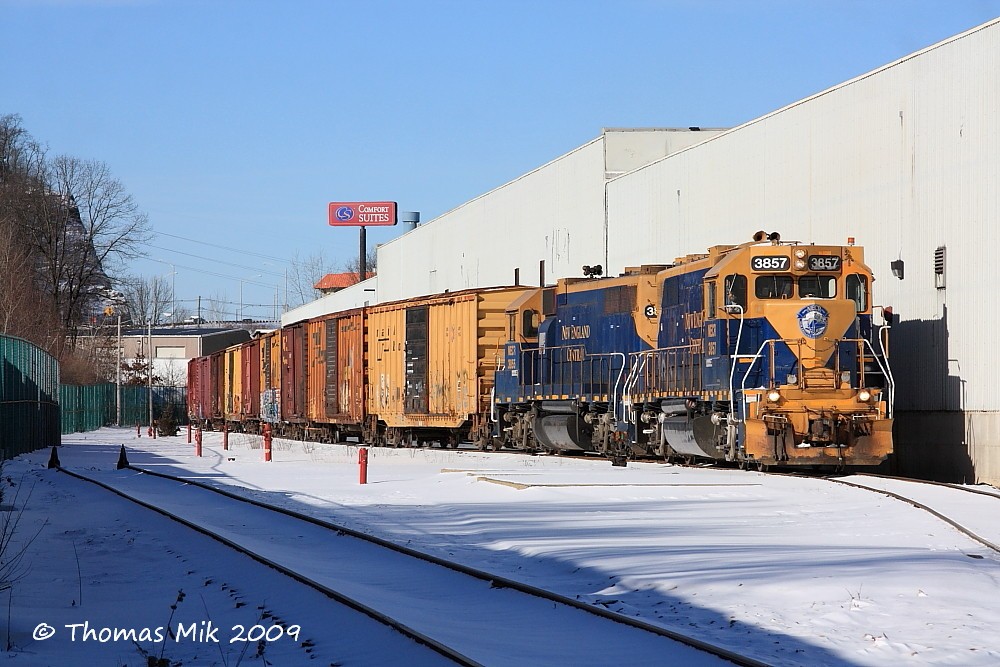A New England Central Railroad freight train delivers goods to Freeport-McMoran Copper (formerly Phelps-Dodge) in Norwich, Connecticut. Photo by Tom Mik.
The Connecticut Mirror

The logic seems sound: If more of Connecticut’s goods were moved on freight trains instead of trucks, diesel fuel emissions would be reduced, traffic would be lighter, and the state would save money on highway widening and repairs.
But in the last two rounds of federal transportation grants, all of the grants in Connecticut went to moving commuters on rail, pedestrians on sidewalks, or people in cars. Moving freight on rails got nothing.
“It’s less sexy,” said state Rep. David McCluskey, D-West Hartford, who as a member of the General Assembly’s Transportation Committee has pushed for improvements to the web of short-line routes in Connecticut.
“If we could significantly increase the amount of freight that moves through our state on rail,” McCluskey said, “we could unclog our highways, reduce the damage of overly weighted trucks on our roads, and add passenger capacity. Freight rail is greener.”
But Connecticut’s rail network is old and in need of repair-a situated highlighted last month when several freight cars holding ethanol derailed in Willimantic on state-owned tracks used by two of the bigger freight lines in the state, the New England Central Railroad and the Providence & Worcester Railroad. Nothing spilled, but it was the third derailment in that area this year.
And upgrading tracks only addresses part of the problem. Freight lines in the state can’t carry as much weight as lines in the rest of the country. The routes here are short lines and currently can’t easily connect to the national lines that come into ports west of the Hudson River. The only routes for a freight train to reach New York State are through Queens or Albany.
In short, freight lines in Connecticut have been staggering along for years on outdated rails the companies say they can’t afford to fix without help.
The benefits of freight
Green might seem an odd moniker for century-old rails on which diesel-fueled cars run. But the math is fairly sound, even on Connecticut’s aging rails. Freight trains carry more tonnage per gallon of diesel fuel than a truck.
Of course, the difference between freight and truck efficiency varies depending on the freight train. Those on the shorter and older rail lines in the east tend to use more fuel in stopping and starting and can’t carry as much as the “double-stack” trains used in the West, for instance.
But in 23 comparisons the Federal Railroad Administration made in a 2009 report, freight trains used less fuel for the same amount of goods carried than trucks did. Fuel efficiency ranged from 156 to 512 “ton miles per gallon,” compared to truck efficiency of only 68 to 133.
Looked at another way, each freight car on Connecticut lines is allowed to carry between 70 and 100 tons of load per car. A tractor-trailer by law is allowed to carry only 40 tons. So one freight train pulling 10 rail cars can carry as much weight as 175 to 250 trucks.
The comparison is especially striking when you consider that Connecticut’s rails aren’t as heavy as elsewhere. Right now, most of Connecticut’s rail bridges are rated to carry 263,000-pound cars. Modern standards for freight rail are 286,000 pounds.
“If you are shipping to here from Chicago, you can’t fill the car all the way,” said Charles Hunter, director of state relations/east for Rail America, which owns Connecticut Southern and New England Central railroads. Connecticut, he said, is “less competitive against trucks and against other places in New England that can take the heavier cars.” Still, boosting freight here would provide huge benefits in reducing truck congestion and air pollution, McCluskey said.
State rail plan has big goals
In November, the state Department of Transportation began seeking public comments on its Connecticut State Rail Plan 2010-2014, which states two big goals for freight trains. First, it says the goal is to “increase freight rail usage by 25 percent to reduce truck traffic and energy consumption.” Elsewhere in the report, the DOT, noting that the rails need work for both passenger and freight trains, states a regional goal of increasing rail freight volume by 20 percent over the next 20 years.
The report also outlines specific repairs it wants to make on freight lines. But rail companies have been unable to secure any federal stimulus money, and the DOT has budgeted no money for the lines, some of which date to the late 19th century. A 2007 law designated $2.5 million for freight, but the money was later put into improving at-grade crossings. There is currently no other state money directly available for freight improvements.
DOT spokesman Judd Everhart said the state wants to help freight rail. He noted that the DOT did receive $120 million from the Federal Railroad Administration to improve the New Haven-Hartford-Springfield line. Although the money was designated for passenger rail, some freight trains run on that same route.
“It is a priority for the Department to improve and maintain the rail infrastructure on this heavily used freight line and other lines to allow for 286,000-pound rail freight cars,” Everhart said. “Allowing for 286,000 pounds will give the freight railroad companies a competitive advantage.”
One of the big freight rail companies in Connecticut, the Providence & Worcester Railroad, is trying to upgrade the rails by seeking $5.3 million through the federal Program for Capital Grants for Rail Line Relocation, said Marie Angelini, general counsel for the Worcester-based railroad, which is also pursuing a loan.
Angelini acknowledged that freight can benefit from passenger rail projects on the rails. “We’re seeing a lot of attention being paid to passenger railroads,” she said.
The Obama administration’s emphasis on improving rail rights-of-way for high-speed trains proves the point. “By and large, a railroad that someone decides has a route that is a good and worthy passenger route will get huge dollars to upgrade for passenger rail. It’s also very helpful to freight because it improves the lines, but if the Willimantic branch were a potential passenger right of way, we would have received the money.”
McCluskey said he’s frustrated. “The freight rail lines in our state are undercapitalized. They have one real lobbyist. None of the environmentalists I have talked to have tried to run with freight rail.”
The freight companies say that trains are good for moving construction debris, wood, gravel, recyclable glass, animal feed, and chemicals-lots of them, “all kinds of things you don’t want on the highway next to someone tooling along at 90 miles an hour on their BlackBerry,” Angelini of P&W said.
“We understand that passenger and commuter rail is extremely important in Connecticut, but so is freight rail,” Hunter of Rail America said. “Freight rail is connected to jobs. People who work in these facilities depend on freight rail. It’s kind of being left behind in Connecticut, and it needs to be a higher priority.”
About This Article
I wrote this article for the Connecticut Mirror. Its original posting can be found at http://ctmirror.org/.
